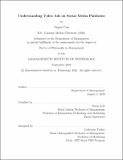Understanding Video Ads on Social Media Platforms
Author(s)
Cao, Yiqun
DownloadThesis PDF (14.56Mb)
Advisor
Aral, Sinan
Terms of use
Metadata
Show full item recordAbstract
This dissertation consists of three chapters that explore the effects of creative elements in video ads on social media platforms and investigate how these ads impact consumer behavior in both normal times and times of crisis.
The first chapter performs a comprehensive exploration of video ads on social media platforms using large-scale observational data. Understanding what makes video advertising effective in boosting performance is a crucial task, given firms’ heavy investment and its ubiquitous presence in our daily life. It is also a demanding task due to the limited availability of video ad data and the complexity of video features. We first conduct unsupervised clustering to provide a taxonomy of video ad features to understand the commonalities and differences that designers favor when creating video ads. We find videos with much speech tend to have a lower presence of text and a higher presence of people. Second, we perform a feature importance ranking after constructing meaningful and representative creative features. We run multilevel linear models of selected video and campaign features on ad performance outcomes to gain insights into the effectiveness of video elements. We observe that text and its early appearance deteriorate view-related outcome metrics, whereas the presence of people and their early appearance improve view-related metrics. Third, we explore the heterogeneous effects of basic video elements on advertising performance across different platforms, industries, and campaign objectives.
The second chapter follows up on the results from the previous chapter and investigates how algorithmic optimization interacts with whether the firm features the product early or late in the ad. Advertising algorithms seem sophisticated in achieving a single specific objective, such as views and conversions for digital video ads. However, the algorithm’s focus on only one goal may present problems for advertisers if they hope the ad could achieve multiple goals such as building awareness, raising interest, and boosting conversions. Using a field experiment, we find that ad algorithms can effectively achieve the prescribed video objective - for example: changing the campaign objective from view to click would significantly improve the probability of clicks while decreasing the short-duration video view probability. The mechanism is that the target audience will change as the campaign goal changes, because optimization algorithms always try to find the "right" audience to maximize the specified performance metrics. We find that the algorithm’s single-minded pursuit of a specified objective can be moderated by how quickly content about the product is revealed. Our results suggest that in advertising markets where algorithms are programmed to narrowly fulfill one objective, advertisers need to tailor content to engage users in a way that helps them achieve multiple objectives.
The third chapter investigates how people’s response to digital ads changed with fluctuations in the COVID pandemic situation. As new variants keep coming, the world has experienced multiple rounds of COVID-19 virus hits. With the high mutation rate of the virus, people may have to live with COVID-19 and its variants for quite a while. The main research question addresses how people’s responses to online ads, in the form of views and conversions when viewing them, change with the ups and downs of the pandemic’s severity, specifically its perceived severity as reflected by stay-at-home behavior. We use a difference-in-differences identification strategy and a fixed-effects model. The main results show that ad conversions increase as the pandemic situation becomes more severe. We find the effect stems not just from people replacing offline shopping with online shopping interchangeably, but also from the psychological impact of COVID. Since people are likely to coexist with COVID-19 for the foreseeable future, our research helps firms and businesses better understand consumers’ behavior and better adjust to future changes in the pandemic situation through their marketing practices.
Date issued
2022-09Department
Sloan School of ManagementPublisher
Massachusetts Institute of Technology